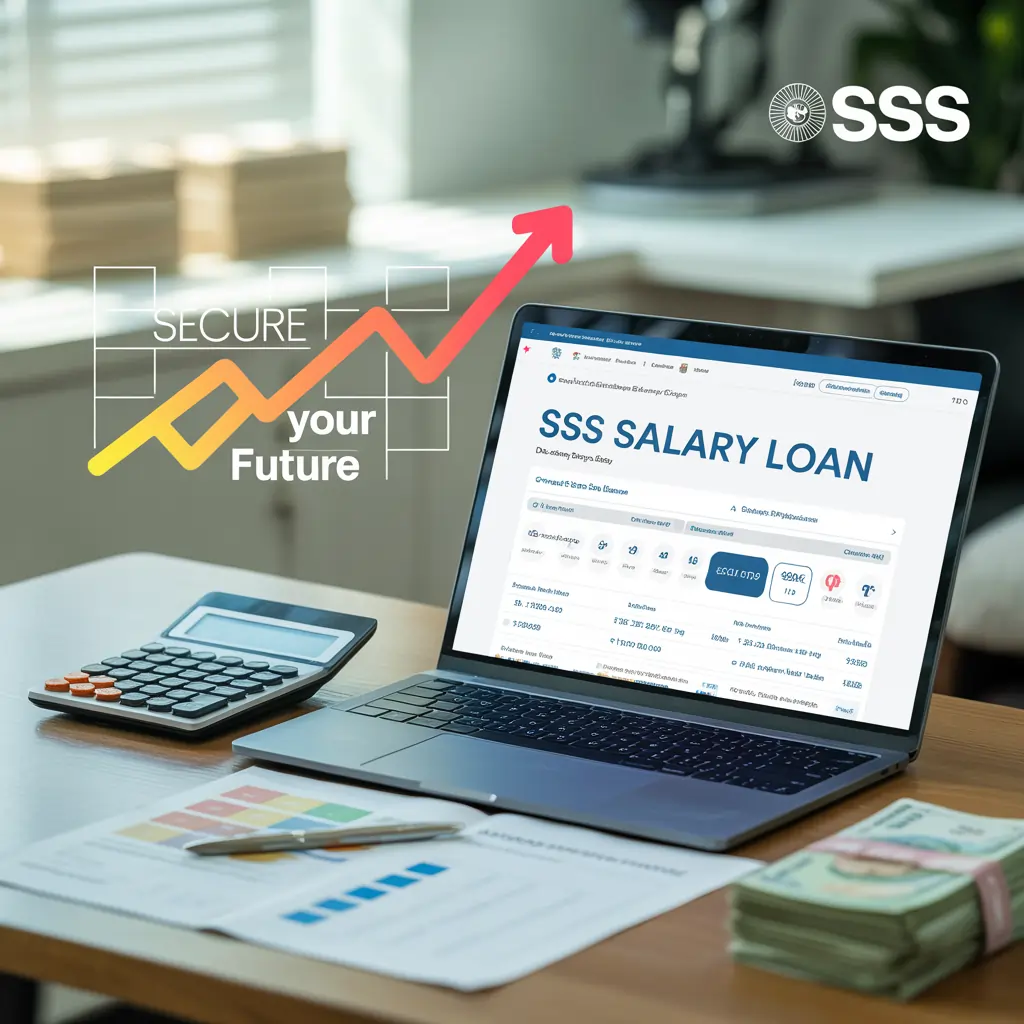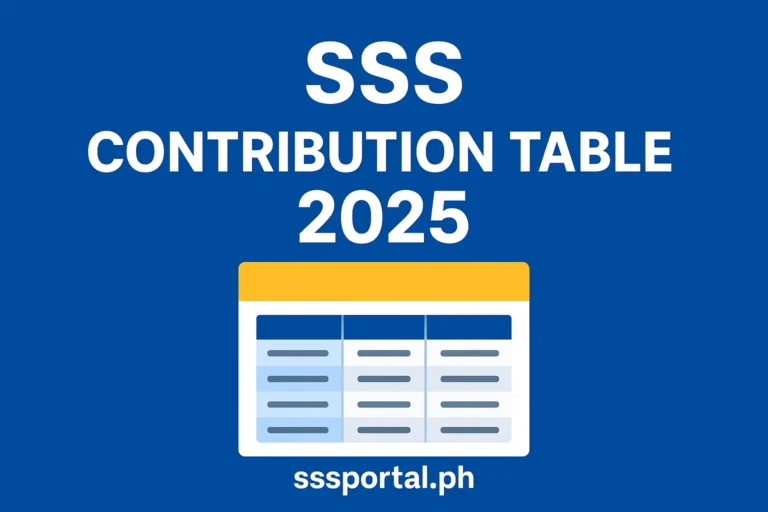Many workers wonder how they can quickly get financial help during tough times. An SSS Salary Loan gives qualified members a way to borrow money from the Social Security System using their monthly contributions as the basis. If you’re looking for SSS Salary Loan Guide to Application, Requirements, and Processing Time login here.
This loan is designed for short-term needs, like paying bills, dealing with emergencies, or covering extra costs. It’s available to employees, self-employed people, and voluntary members who meet certain conditions. Also, You can access each and everything through SSS Portal Login.
Understanding SSS Salary Loan
The SSS Salary Loan lets qualified members of the Social Security System access funds for immediate financial needs. Understanding how these loans work and what benefits they offer can really help when you’re in a pinch.

What is an SSS Salary Loan
An SSS Salary Loan is a cash loan program from the Social Security System (SSS) in the Philippines. It’s open to currently employed, self-employed, or voluntary members who meet the eligibility criteria.
The idea is to help borrowers cover short-term needs by offering funds paid back through monthly payments. Loan amounts depend on your monthly salary credit and posted contributions.
You can use the loan for emergencies, medical bills, or even education needs. Employed borrowers usually pay through salary deduction, while others pay over the counter.
SSS sets the interest rates and loan terms. It’s all pretty straightforward, but you’ll want to check the latest details before applying.
Purpose and Benefits
The main purpose of the SSS Salary Loan is to give financial assistance to SSS members facing short-term money problems. Members can use this loan for urgent expenses like hospital bills, tuition fees, or emergency repairs.
Key benefits include:
- Quick access to cash
- Simple and easy application process
- Affordable interest rates
- Flexible repayment options
The loan helps members avoid high-interest personal loans from other lenders. Members can also keep their SSS benefits since taking a salary loan doesn’t disqualify them from other SSS programs.
Even self-employed and voluntary members can apply, as long as they meet the contribution and eligibility rules.
Types of SSS Salary Loans
There are two main types of SSS Salary Loans: the one-month salary loan and the two-month salary loan.
- One-Month Salary Loan:
Borrowers may apply for a loan equal to one month of their average monthly salary credit. This one’s handy for smaller, urgent needs. - Two-Month Salary Loan:
Eligible members can get a loan equal to two months of their average salary credit. This is better for bigger cash needs.
Which type you get depends on your posted contributions and eligibility. The terms, interest rates, and repayment periods also differ by loan type.
The SSS website has tables and guidelines to help you figure out possible loan amounts and options. Each type aims to give practical help without piling on debt.

Eligibility and Requirements
To apply for an SSS Salary Loan, members need to meet certain criteria and submit required documents. Both employed and self-employed members have specific rules, and you’ll need valid identification.
Eligibility Criteria
Applicants must be active SSS members with at least 36 posted monthly contributions, with six of those made within the last 12 months before applying.
For employed members, the employer should be updated with SSS salary loan remittances. Self-employed and voluntary members must have posted contributions too.
The applicant should be under 65 years old at the time of application. You can’t have an overdue SSS loan or be disqualified due to fraud.
If you had a previous loan, it must be paid in full. First-timers shouldn’t have any outstanding balances from earlier loans.
Required Documents
Applicants must submit a completed SSS Salary Loan Application Form. Employed members need employer certification, signed and stamped.
If you’re applying through a representative, include an authorization letter and valid IDs for both parties. Some branches let you submit online through the SSS website or My.SSS portal.
Self-employed and voluntary members might need to show proof of income, like business permits or tax documents, if SSS asks. Make sure photocopies are clear and readable.
Valid IDs for Application
A valid government-issued ID is required. SSS accepts these common IDs:
- SSS digitized ID or Unified Multi-Purpose ID (UMID)
- Driver’s License
- PASSPORT
- Postal ID
- Tax Identification Number (TIN) card
- NBI Clearance
- Senior Citizens Card
- GSIS E-Card
- Company ID (for employed members)
Bring at least one primary ID or two secondary IDs with a photo and signature. Don’t use expired IDs. Bringing the original and a photocopy can speed things up.
Eligibility for Voluntary and Self-Employed Members
Voluntary and self-employed members need at least 36 monthly contributions, with six posted in the past year. They should be up to date with SSS membership and contributions at application time.
Proof of income might be needed, like receipts or business documents. It’s also smart to keep your SSS records updated.
If you’ve switched membership status, make sure your records are merged and clear to avoid delays. Having the right IDs ready helps a lot.
SSS Salary Loan Amount and Terms
The SSS Salary Loan depends on your average salary contributions and follows set rules for amount, rates, and repayment. Always check your eligibility and the latest guidelines before applying.
Maximum and Minimum Loanable Amounts
The minimum amount you can borrow is equal to one month’s salary loan. The maximum is up to two months’ salary loan, based on your average monthly salary credit (MSC) for the last 12 months.
- One-Month Salary Loan: Members can get a loan equal to their average MSC, rounded up to the next higher ₱1,000.
- Two-Month Salary Loan: Qualified members may borrow twice their average MSC, also rounded up to the next higher ₱1,000.
SSS reviews your posted contributions and any existing loan balance to decide the final amount. If you have an unpaid loan, SSS will deduct that from your new loan.
Monthly Salary Credit and Loanable Amount
Your monthly salary credit (MSC) is the basis for figuring out how much you can borrow. SSS averages your last 12 posted MSCs.
If your contributions are inconsistent, only those paid on time count. Here’s a simple example:
| Average MSC | 1-Month Salary Loan | 2-Month Salary Loan |
|---|---|---|
| ₱5,000 | ₱5,000 | ₱10,000 |
| ₱15,000 | ₱15,000 | ₱30,000 |
| ₱20,000 | ₱20,000 | ₱40,000 |
You can’t borrow more than the allowed maximum, even if you ask for a bigger amount. Unposted contributions or delinquent loans may lower the final amount SSS releases.

Interest Rates and Service Fees
The SSS Salary Loan charges a fixed interest rate of 10% per year on your outstanding principal balance. Interest is computed on a diminishing balance, so it drops as you pay down the loan.
There’s also a service fee of 1% of the approved loan, automatically deducted before you get your money. For example, if you get ₱20,000, the service fee is ₱200.
If you pay late, SSS charges a penalty interest of 1% per month on overdue amounts. All terms are in the SSS loan disclosure statement, so give that a look.
Repayment Terms and Schedules
The standard repayment term is two years or 24 monthly installments. Payments start on the second month after you receive the loan.
Each payment is due monthly, and the schedule is fixed in the loan disclosure statement. Make payments on or before the due date to avoid penalties.
You can pay through SSS partner banks or payment centers. If you’re employed, your employer may deduct payments from your salary.
Check your outstanding balance and payment schedule anytime through the SSS online portal. That way, you won’t accidentally miss a payment.
How to Apply for an SSS Salary Loan
You can apply for an SSS Salary Loan online or at a branch. Both options follow a clear set of steps and need specific documents or online forms.
Step-by-Step Application Process
First, make sure you’re an active SSS member with at least 36 posted monthly contributions, six of which are within the last year. You’ll need an SSS number and no disqualifying penalties, like a defaulted loan.
Here’s the basic rundown:
- Prepare Requirements: Gather two valid IDs (at least one with a photo), your filled-out Member Loan Application Form, and your SSS number.
- Choose a Method: Decide if you want to apply online via the my.SSS portal or in person at a branch.
- Submit Application: Complete the process for your chosen method—either upload or hand in your form.
- Wait for Approval: Processing time varies depending on how you apply.
- Check Application Status: You can check your loan status online or by visiting the branch.
Application via my.SSS Portal
Register for a my.SSS account at the SSS Member Portal if you haven’t already. This is available to all members with an active SSS number and updated contributions.
Steps for applying online:
- Log in to the my.SSS Portal.
- Click E-Services, then select Apply for Salary Loan.
- Fill out the Member Loan Application form.
- Review everything before you submit.
- After submitting, you’ll get a confirmation message and tracking number.
Online application is usually faster and gives you real-time updates on your status. The portal also lets you check loan eligibility, outstanding balances, and past transactions.
Onsite Application at SSS Branches
If you’d rather apply in person, head to any SSS branch. Bring your original and photocopies of valid IDs and your filled-out Member Loan Application Form.
Basic steps for branch application:
- Go to the nearest SSS branch.
- Submit your documents at the Member Services section.
- Get an acknowledgment or transaction slip after applying.
Onsite applications can take longer, especially when it’s busy. You can ask SSS staff about your loan status or use self-service kiosks if they’re available. Double-check your documents before you go—missing something is a real hassle.
Disbursement of SSS Salary Loan
SSS salary loan proceeds use cashless methods now. Applicants need to enroll an account, pick a disbursement channel, and wait for the loan to get credited.
Disbursement Account Enrollment Module (DAEM)
The Disbursement Account Enrollment Module (DAEM) is a must before SSS releases any loan or benefit. Members log in to their My.SSS account and register their bank account, e-wallet, or other payout option on the DAEM page.
Accepted accounts include banks in PesoNet, e-wallets like GCash and Maya, and some payment centers. The account name has to match the member’s to avoid problems.
Steps:
- Go to My.SSS and open the DAEM page.
- Select and enter payment details (bank account, e-wallet, or remittance center).
- Upload a clear photo of a valid ID and supporting docs if needed.
- Wait for SSS to validate the account. This can take a few days.
If you don’t enroll the right account, your loan gets delayed.
Disbursement Channels and E-wallets
SSS uses several cashless channels to send loan proceeds. Members can pick a PesoNet bank account, a qualified e-wallet, or sometimes a partner remittance center.
PesoNet credits funds directly to local banks, but timing depends on the bank’s cut-off. E-wallets like GCash and Maya are popular for their speed and easy access on your phone.
Not every account or center is accepted, so always check the SSS list before submitting. If you use an e-wallet, make sure it’s verified and active. Wrong or inactive details cause failed transactions, which means you’ll have to re-enroll and wait again.

Loan Proceeds and Crediting
After SSS approves the loan, they credit the proceeds to your chosen account—usually within 3-5 working days. Delays pop up if there are technical issues or if your account details are wrong.
Loan proceeds come as a lump sum. SSS doesn’t give out cash loans in person—they do it all digitally for safety and convenience.
- For bank accounts, funds show up after clearing.
- For e-wallets, you’ll get a notification and can use or withdraw the money right away.
- Payment centers are rare, and SSS sends instructions if you choose that route.
Borrowers should check their transaction history and notifications to confirm receipt. If something goes wrong, reach out to SSS or your bank/e-wallet provider.
Repayment and Penalties
Borrowers pay the SSS salary loan in monthly installments over a set term. Missing payments leads to extra interest and penalties. There are rules to follow before you can apply for a new loan.
How to Repay Your SSS Salary Loan
The SSS salary loan is usually paid in 24 equal monthly installments. Repayment starts in the second month after loan approval.
If your employer grants the loan, they’ll deduct the payment from your salary. Self-employed and voluntary members need to pay at any SSS branch, accredited bank, or authorized payment center.
The SSS portal also lets you pay bills online. Payments are due on or before the monthly deadline, which depends on your SSS number or employer.
Paying on time avoids extra fees and keeps your account in good standing.
Penalties for Late Payments
Miss the monthly payment deadline and SSS charges penalty fees and more interest. This increases the total loan cost.
There’s a 1% penalty per month on overdue amounts, on top of the regular 10% annual interest if you’re late. These add up until you settle the missed payment.
Falling behind on several payments can really increase your balance. It might also stop you from renewing the loan or getting other SSS benefits until you catch up.
Table: Sample Penalties for Late Payments
| Days Late | Penalty Rate | Additional Cost |
|---|---|---|
| 1–30 | 1% per month | Increases monthly |
| 31+ | Adds up each month | Higher balance |
Loan Renewal Guidelines
If you want to renew your SSS salary loan, you need to have paid at least 50% of the original principal and made all payments on time.
If you renew early, SSS deducts the remaining balance from your new loan. Renewal applicants must meet all eligibility requirements.
Your account can’t be in default—no overdue or missed payments. SSS checks this automatically before approving a renewal.
Tracking and Managing Your SSS Salary Loan
Borrowers have a few ways to track their SSS Salary Loan. Keeping an eye on payments and checking updates online helps avoid missed payments and nasty surprises.
Checking Loan Status Online
Members can see their loan status and application status by logging in to the My.SSS Portal. The site shows key updates, including if your application is approved or still pending.
Once signed in, look for the “Loans” tab on the dashboard. Pick “Loan Status/Loan Info” to see details and your application date.
No internet? Call the SSS hotline at 1455 or (02) 8920-6446-55 for updates. It’s smart to check your loan status often, especially until you get your funds.
Outstanding Loan Balance
The outstanding loan balance shows what you still owe, including principal, interest, and penalties.
Check this by signing in to the My.SSS Portal, choosing “Loans,” and clicking “Loan Statement of Account.” You’ll see your total balance, due dates, and any missed or late payments.
Staying on top of your balance helps you plan payments and dodge extra charges. If something looks off, call the SSS hotline or visit a branch. Better to ask than get caught off guard.
Common Issues and Solutions
Borrowers do run into delays or denials with SSS Salary Loan applications. Knowing the main reasons for problems (and how to fix them) can save you a headache.
Delays in Loan Processing
Lots of applicants get stuck waiting for SSS Salary Loan approval. Typical processing time is 5-7 working days after you submit everything. Delays usually happen if forms are incomplete, records don’t match, or your employer hasn’t updated SSS contributions.
To speed things up, double-check all info before submitting. Make sure SSS records match your personal and job details. Remind your employer to post recent SSS contributions—missing payments cause delays all the time.
Checklist to avoid delays:
- Submit all required documents
- Check employer payment of monthly contributions
- Make sure all information matches SSS records
Application Rejection Reasons
Rejections usually come from avoidable mistakes. SSS turns down members with less than 36 monthly contributions, a current loan in default, or an employer who’s not up to date. Wrong or mismatched data in your records can also get you rejected.
Main rejection reasons:
| Reason | Details |
|---|---|
| Not enough posted contributions | At least 36 monthly contributions required |
| Employer not updating contributions | Payments not posted in SSS records |
| Existing loan not yet paid or in default | Outstanding balances block new loans |
| Personal info mismatch in SSS records | Name, date of birth, or address errors |
To fix these, check your records before applying and pay off any old loans. Contact your employer or visit an SSS branch to sort out info errors and update records faster.
Frequently Asked Questions
People can apply for an SSS salary loan by following steps on the SSS online platform. You’ll need to meet some requirements and understand the interest rate, repayment process, and how to track your loan.
